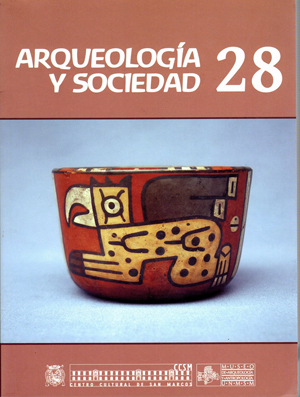BIOLOGY IN TOPONYMY OF PALLASCA
DOI:
https://doi.org/10.15381/arqueolsoc.2014n28.e12219Keywords:
Toponymy, geographic regions, biology, linguistic, Pallasca.Abstract
The biological species develop in determinate ecological levels. The people, when communicating, process cognitively the relation biology and geography, and fix it in his tongue through proper names or toponyms. The purpose of the present study is to show that these toponyms, on the one hand, they reflect the biological entities that accord to the ecological levels and, by another, constitute a testimony of tongues and practics of missing villages in the province of Pallasca (Áncash). The data are part of a vast corpus collected in situ, in the 2012; obtained from several informants of different social level and degree of studies; basically elder. Then these were selected and classified according to a biological entity: animal or plant and according to their location in any of the «four» natural regions of the area of study. The results show a total of 136 toponyms, of which 100 (73,53%) contain names of plants and 36 (26, 47%), of animals. The region that contains greater quantity of toponyms with reference to biological entities is the quechua region: with 44 (32,35%) names of plants and 13 (9,56%), of animals. Followed by the suni or jalca: 26 (19,12%) names of plants and 26 (19,12%), of animals. Afterwards the yunga, with 29 (21,32%) names of plants and the 1 (0,74%), of animal. Finally, the ruparupa region, with 8 (5,88%) names of plants only. With respect to etymology: 35 (25,74%) names are of Spanish origin, 65 (47,79%) are quechua; 11 (8,09%), culle and 25 (18,38%), of uncertain origin.Downloads
Published
Issue
Section
License
Copyright (c) 2014 María del Carmen Cuba M.

This work is licensed under a Creative Commons Attribution-NonCommercial-ShareAlike 4.0 International License.
THE AUTHORS RETAIN THEIR RIGHTS:
a. The authors retain their trademark and patent rights, and also on any process or procedure described in the article.
b. The authors retain the right to share, copy, distribute, perform and publicly communicate the article published in the Arqueología y Sociedad (for example, place it in an institutional repository or publish it in a book), with an acknowledgment of its initial publication in the Arqueología y Sociedad.
c. The authors retain the right to make a subsequent publication of their work, to use the article or any part of it (for example: a compilation of their works, notes for conferences, thesis, or for a book), provided that they indicate the source. of publication (authors of the work, journal, volume, number and date).






